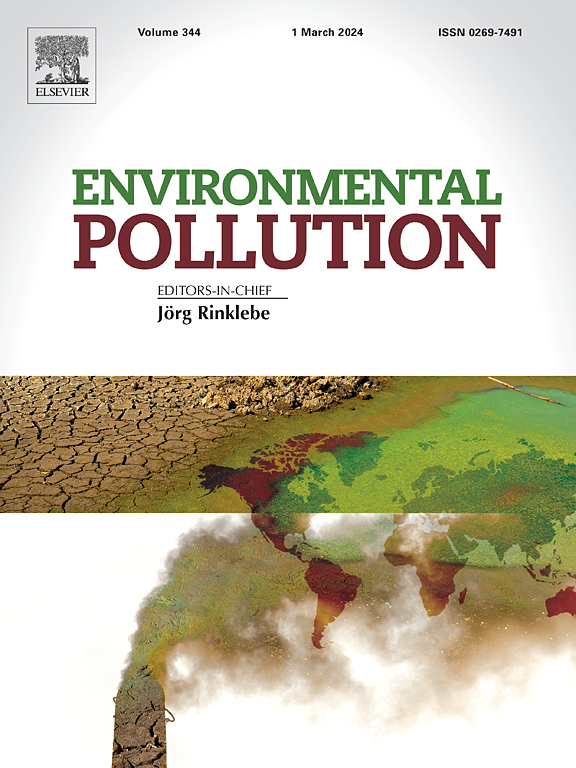多卤咔唑在城市环境中的大气命运与沉积
IF 7.6
2区 环境科学与生态学
Q1 ENVIRONMENTAL SCIENCES
引用次数: 0
摘要
多卤代咔唑(phcz)由于其类二恶英毒性和在水生环境中的广泛分布而引起了人们的关注。然而,关于phccs在大气环境中的发生、命运和影响的知识是有限的。本研究调查了2024年冬季加拿大多伦多11种phcz的空气浓度和大气沉降。为了更好地了解phccs从城市环境到接收流域的运输,还评估了大气沉降对phccs到城市河流质量负荷的事件效应。结果表明,3-氯- 9h -咔唑(3- ccz)和3,6-二氯- 9h -咔唑(36-CCZ)是所有基质中主要的phcz。气相中3-CCZ的浓度(0.020±0.013 pg/m3)与36-CCZ的浓度(0.030±0.022 pg/m3)相似,而颗粒相中36-CCZ的浓度(0.086±0.045 pg/m3)高于3-CCZ(0.029±0.022 pg/m3)。温度正影响36-CCZ向气相的分配。虽然这两种phcz经常在空气中发现,但估计的有毒当量和估计的每日摄入量表明,它们不太可能通过户外吸入对人体健康造成与二恶英类似的影响有关的风险。3-CCZ和36-CCZ的大气沉降量分别为45±63 pg/m2/d和89±60 pg/m2/d。在较低的温度下,3-CCZ的清除率增加,因为对降水的分配更大。此外,雨水和融雪可以增加城市河流中这两种phccs的质量通量(大约高达3倍),并导致更多的phccs被输送到水生环境。本文章由计算机程序翻译,如有差异,请以英文原文为准。

Atmospheric Fate and Deposition of Polyhalogenated Carbazoles in Urban Environment
Polyhalogenated carbazoles (PHCZs) are of emerging environmental concern due to their dioxin-like toxicity and widespread distribution in the aquatic environment. However, knowledge of the occurrence, fate, and impacts of PHCZs in the atmospheric environment is limited. The present study investigated air concentrations and atmospheric deposition of 11 PHCZs in Toronto, Canada, during the winter of 2024. The event-based effects of atmospheric deposition on the mass load of PHCZs to urban streams were also evaluated to better understand the transport of PHCZs from urban environments to receiving watersheds. Results showed that 3-chloro-9H-carbazole (3-CCZ) and 3,6-dichloro-9H-carbazole (36-CCZ) were the predominant PHCZs in all matrices. Similar concentrations of 3-CCZ (0.020 ± 0.013 pg/m3) and 36-CCZ (0.030 ± 0.022 pg/m3) were found in the gas phase, while higher concentrations of 36-CCZ (0.086 ± 0.045 pg/m3) were observed in the particle phase compared to 3-CCZ (0.029 ± 0.022 pg/m3). Temperature positively affected the partitioning of 36-CCZ to the gas phase. Although these two PHCZs were frequently found in the air, the estimated Toxic Equivalent Quantity and Estimated Daily Intake suggested they were unlikely to pose risks to human health relevant to dioxin-like effects via outdoor inhalation. The atmospheric deposition of 3-CCZ and 36-CCZ was 45 ± 63 pg/m2/day and 89 ± 60 pg/m2/day, respectively. The scavenging of 3-CCZ increased at lower temperatures due to greater partitioning to precipitation. In addition, rain and snowmelt could increase the mass flux of these two PHCZs (approximately up to 3-fold) in urban streams and result in more PHCZs being delivered to aquatic environments.
求助全文
通过发布文献求助,成功后即可免费获取论文全文。
去求助
来源期刊

Environmental Pollution
环境科学-环境科学
CiteScore
16.00
自引率
6.70%
发文量
2082
审稿时长
2.9 months
期刊介绍:
Environmental Pollution is an international peer-reviewed journal that publishes high-quality research papers and review articles covering all aspects of environmental pollution and its impacts on ecosystems and human health.
Subject areas include, but are not limited to:
• Sources and occurrences of pollutants that are clearly defined and measured in environmental compartments, food and food-related items, and human bodies;
• Interlinks between contaminant exposure and biological, ecological, and human health effects, including those of climate change;
• Contaminants of emerging concerns (including but not limited to antibiotic resistant microorganisms or genes, microplastics/nanoplastics, electronic wastes, light, and noise) and/or their biological, ecological, or human health effects;
• Laboratory and field studies on the remediation/mitigation of environmental pollution via new techniques and with clear links to biological, ecological, or human health effects;
• Modeling of pollution processes, patterns, or trends that is of clear environmental and/or human health interest;
• New techniques that measure and examine environmental occurrences, transport, behavior, and effects of pollutants within the environment or the laboratory, provided that they can be clearly used to address problems within regional or global environmental compartments.
 求助内容:
求助内容: 应助结果提醒方式:
应助结果提醒方式:


